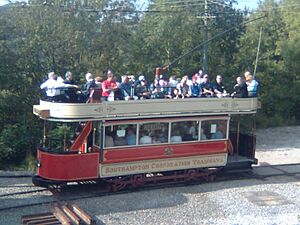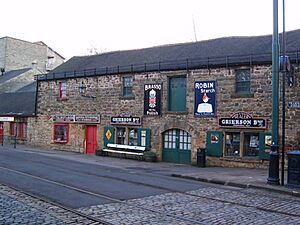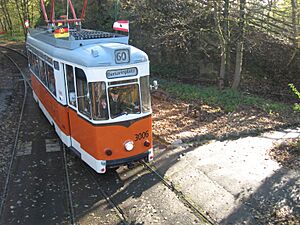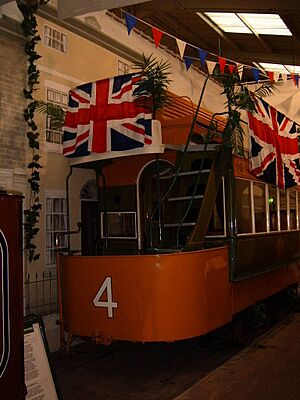Crich Tramway Village facts for kids
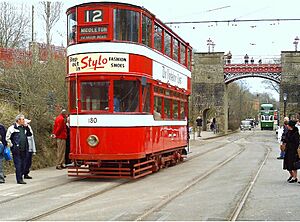
Crich Tramway Village is an open-air museum of trams and tramways in Crich, Derbyshire, England. It is also known as the National Tramway Museum. The museum is set up like an Edwardian village. It has a street with shops, including a sweet shop, a café, and a gift shop. Other buildings you can see are the Red Lion Pub from Stoke-on-Trent, the Derby Assembly Rooms, and the Burnley Tramways Offices. There are also tram sheds and special displays.
You can ride on tram lines that go for about 1 mile (1.6 km) from the village. The museum also has a collection of old street furniture from all over the United Kingdom. The trams at the museum used to run on streets in different towns and cities. Most of the trams at Crich were used in the United Kingdom before the 1960s. Some even came from other countries. Many of these trams were saved and restored after their services stopped in the cities.
Contents
History of the National Tramway Museum
Before World War II, trams were a very important way for people to travel in many cities in the United Kingdom. Horse-pulled trams first appeared in the late 1800s. After World War II, many tram systems started to close down. People thought that trams got in the way of cars and buses. Also, it became cheaper to use fuel for buses than to make electricity for trams. Most tram networks in the United Kingdom had closed by 1962. Only one tramway, the Blackpool tramway, kept running and still does today.
In 1948, a group of tram enthusiasts decided to buy an open-top tram. They had ridden this tram on the very last journey of the Southampton Tramways. They bought Southampton No. 45 for just £10. At that time, there were no working museums or heritage railways in Britain. So, the idea of amateurs running a tramway seemed almost impossible.
In 1955, the Tramway Museum Society was started. After a long search, the Society chose a place for the museum in 1959. The Talyllyn Railway Preservation Society found the site. They were taking apart old tracks from George Stephenson's railway for a project in Wales.
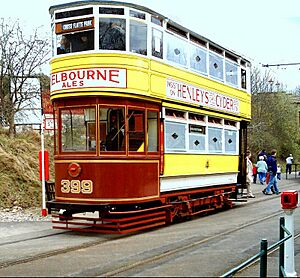
In the 1840s, George Stephenson was building the North Midland Railway from Derby to Rotherham and Leeds. He found coal buried underground near Clay Cross. He decided to mine it to make money. Crich already had a limestone quarry. Stephenson realized he could use this limestone and coal to make burnt lime for agricultural use. Then he could use his railway to move it.
To connect the quarry at Crich to the limekilns at Ambergate, a new railway was built. This railway was a metre gauge railway, which means its tracks were one meter apart. It is said to be the first of its kind in the world. The museum is built on part of the old Cliff Quarry, which Stephenson's company had bought.
After visiting the quarry, members of the Tramway Museum Society bought part of the site and its buildings. Since then, the society has collected many trams. They also got tracks and power for the trams. Many of the tramcars were also repaired. In 1967, the society decided to create a village around the tramway. This was because trams didn't run in limestone quarries. This was the beginning of Crich Tramway Village. The museum collected a lot of street furniture and even some whole buildings. Many of these buildings have been changed to hold the museum's collections of books, pictures, and archives.
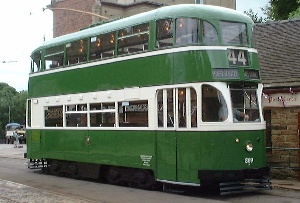
In 1962, the Tramway Museum Society became a company. A year later, it was listed as an educational charity. Since then, the society has grown with help from people all over the world. The Secretary of State for Culture, Media and Sport has said that the museum has a very good collection. It was one of the first 26 museums to be given this special recognition in 1995.
Since the early 2000s, the work of the museum's volunteers and the money earned from visitors has been boosted by grants from the Heritage Lottery Fund. The museum is still an independent charity. This means that the government does not pay for it.
In the early 1990s, the government of the United Kingdom decided that trams could help with traffic problems in the UK. New light rail systems, sometimes called "second generation tramways," opened in cities like Manchester, Sheffield, and Nottingham. Twenty years later, even more systems are being built, like the one in Edinburgh.
Timeline of Key Events
- 1948 - Southampton 45 is bought for £10. This marks the start of British tramway preservation.
- 1955 - The Tramway Museum Society (TMS) is formed.
- 1959 - Crich is chosen as the home for the National Tramway Museum.
- 1963 - The first tram is run with "Bonny" the horse and Sheffield 15.
- 1964 - The first electric tramcar service begins.
- 1968 - New tracks to Wakebridge open. The museum holds its first "Grand Transport Extravaganza."
- 1969 - The museum's special workshops open.
- 1971 - The museum hires its first full-time paid workers.
- 1978 - Leicester 76 starts running. It is the first tramcar to be restored at the museum.
- 1978 - The scenic tramway to Glory Mine opens.
- 1991 - The exhibition hall, a large room for displaying trams, is opened.
- 1992 - The Bowes-Lyon Bridge is opened by the Secretary of State for Transport.
- 1997 - The first "AccessTram," Berlin 3006, starts running. This tram is specially changed to help visitors with less ability enjoy a ride.
- 2001 - Oporto 273 starts running after being restored with money from a Heritage Lottery Fund (HLF) grant.
- 2002 - The workshop viewing gallery, workshop extension, and Red Lion pub open.
- 2008 - The museum gets a HLF grant of £900,000 to restore the Stone Workshop (pictured right). This will turn it into an exhibition and education center.
- 2009 - Cardiff 131 starts running. The museum celebrates its 50th Anniversary with special events called "Crich50."
- 2010 - London Tramlink donates two old works vehicles. Blackpool Transport announces it will donate six trams to the museum between 2010 and 2015.
Tramcar Collection
The museum has over 60 tramcars! They come from many different places around the world. Some examples include Berlin, Blackpool, Chesterfield, Den Haag (in the Netherlands), Douglas, Edinburgh, Glasgow, Liverpool, London, New York, Oporto (in Portugal), and Sheffield.
Most of these tramcars are double-deckers, meaning they have two levels for passengers. Some even have open-tops, which is fun on a sunny day!
About fifteen of the trams are fully working. Every day the museum is open, one to four of these trams are used on the mile-long track. There is also a 1969 Berlin tram that has been changed into an "Access Tram" to help all visitors enjoy the ride.
Many of the trams can be seen at the museum. Some, like Blackpool Dreadnought 59, are stored in the museum's depot at Clay Cross.
How Trams Operate
The museum has trams that use four different ways to move: horse, steam, diesel, and electricity. Electricity is used for most of the trams that carry passengers and for the work trams. However, for one special weekend each year, a horse tram runs.
The museum has five horse trams: Leamington & Warwick 1, Chesterfield 8, Oporto 9, Sheffield 15, and Cardiff 21. But only Sheffield 15 is used for rides. The others are on display. The museum also has a steam tram engine that you can see.
Most tram systems have their overhead wire system built to work with only one type of current collector. This is the part that gets electricity for the tram. The museum has been built to use any of them! This includes trolley poles, bow collectors, and pantographs. Conduit current collection is another way to get power. Blackpool 4 uses this system, and it was also used in London.
Other Places to Explore



